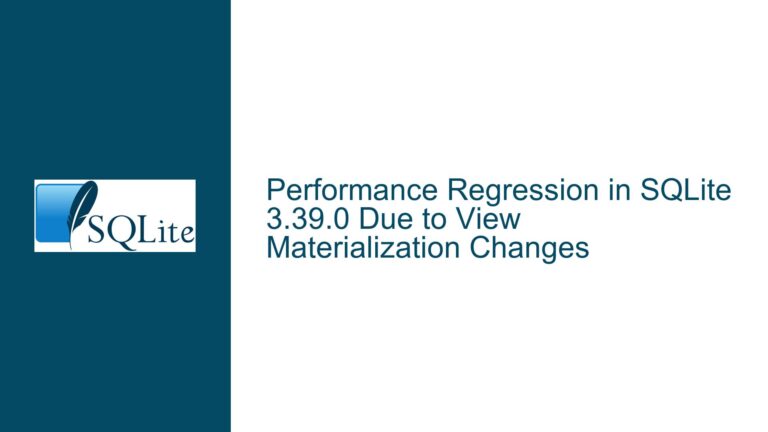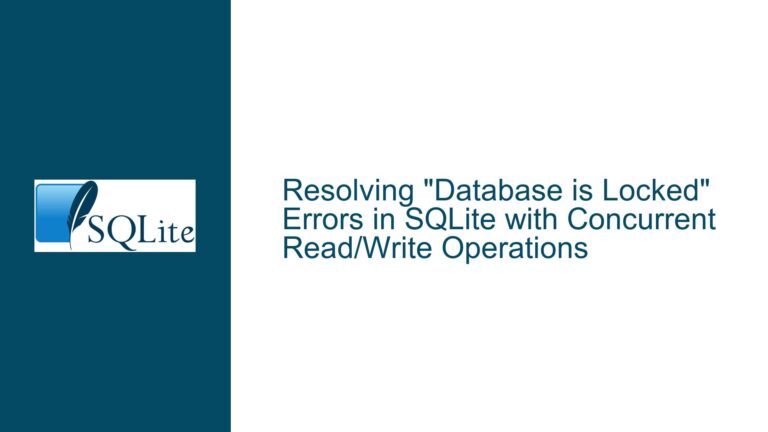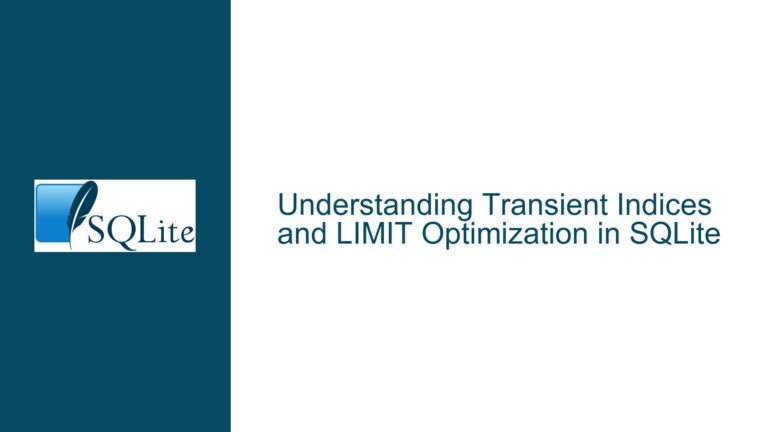SQLite Multi-Database Transaction Locking Behavior
Locking Behavior in Multi-Database Transactions: A Deep Dive
Issue Overview: Multi-Database Transactions and Locking Mechanisms
When working with SQLite, a common scenario involves attaching multiple databases to a single connection and performing transactions that span these databases. For instance, consider a setup where two databases, DB1 and DB2, are attached to a connection. A transaction might read from DB2 and perform read/write operations on DB1. The core question that arises in such scenarios is: What is the locking behavior when this transaction is committed? Specifically, are both DB1 and DB2 locked exclusively, or is only a shared lock acquired for DB2 while an exclusive lock is acquired for DB1?
This question is crucial because it directly impacts the concurrency and performance of the system. If both databases are locked exclusively, it could lead to unnecessary blocking, especially if DB2 is only being read and not written to. On the other hand, if only DB1 is locked exclusively, other transactions that need to read from DB2 could proceed in parallel, thereby improving throughput.
The SQLite documentation provides some insight into this behavior, stating that if a transaction involves multiple databases, a more complex commit sequence is used, which includes ensuring that all individual database files have an EXCLUSIVE lock. However, this description feels somewhat pessimistic, especially in scenarios where some databases are read-only and others are write-intensive. The documentation does not explicitly clarify whether read-only databases are also locked exclusively during the commit phase, leading to potential confusion and suboptimal performance in multi-database setups.
Possible Causes: Why Multi-Database Locking Can Be Problematic
The locking behavior in SQLite is designed to ensure data integrity and consistency, especially in multi-database transactions. However, this behavior can lead to several issues, particularly when dealing with concurrent transactions that span multiple databases. Let’s explore the possible causes of these issues:
Exclusive Locking of Read-Only Databases: One of the primary concerns is whether read-only databases (like DB2 in our example) are locked exclusively during the commit phase. If they are, this could lead to unnecessary blocking, as other transactions that only need to read from DB2 would be prevented from doing so until the transaction is committed. This behavior is particularly problematic in scenarios where read-only databases are frequently accessed by multiple transactions.
Deadlocks in Concurrent Transactions: Another potential issue arises when multiple transactions attempt to write to different databases while reading from the same read-only database. For example, consider two transactions: Transaction A writes to DB1 and reads from DB2, while Transaction B writes to DB3 and reads from DB2. If both transactions attempt to commit simultaneously, they could end up in a deadlock situation, where each transaction is waiting for the other to release locks, leading to a standstill.
Impact of Journaling Modes: The journaling mode used by SQLite can also influence the locking behavior. In the default rollback journal mode, an exclusive lock is required during the commit phase, which can exacerbate the issues mentioned above. However, in WAL (Write-Ahead Logging) mode, the locking behavior is different, and exclusive locks are not required during the commit phase. This can significantly improve concurrency, but it also introduces its own set of complexities and potential issues.
Documentation Ambiguity: The SQLite documentation, while comprehensive, does not always provide clear guidance on the locking behavior in multi-database transactions. This ambiguity can lead to misunderstandings and incorrect assumptions about how locks are acquired and released, resulting in suboptimal database designs and performance issues.
Troubleshooting Steps, Solutions & Fixes: Optimizing Multi-Database Transactions
Given the potential issues outlined above, it’s essential to take a systematic approach to troubleshoot and optimize multi-database transactions in SQLite. Here are some steps, solutions, and fixes to consider:
Understanding Locking Behavior: The first step in troubleshooting is to gain a deep understanding of how SQLite handles locking in multi-database transactions. As mentioned earlier, SQLite ensures that all databases involved in a transaction have an EXCLUSIVE lock during the commit phase. However, this behavior can be influenced by the journaling mode. In WAL mode, exclusive locks are not required, which can improve concurrency. Therefore, it’s crucial to understand the implications of the journaling mode on your specific use case.
Optimizing Database Design: To minimize the impact of locking, consider optimizing your database design. For example, if you have databases that are primarily read-only, you might want to separate them from databases that are write-intensive. This separation can reduce contention and improve concurrency. Additionally, consider using views or triggers to consolidate data from multiple databases into a single database, thereby reducing the need for multi-database transactions.
Using WAL Mode: If your application requires high concurrency and you’re experiencing locking issues, consider switching to WAL mode. WAL mode can significantly improve concurrency by eliminating the need for exclusive locks during the commit phase. However, be aware that WAL mode introduces its own set of complexities, such as the need to manage the WAL file and checkpointing. Therefore, it’s essential to thoroughly test your application in WAL mode before deploying it to production.
Implementing Deadlock Detection and Resolution: Deadlocks can be a significant issue in multi-database transactions, especially when multiple transactions are writing to different databases while reading from the same read-only database. To mitigate this, consider implementing deadlock detection and resolution mechanisms in your application. For example, you could use timeouts or retry logic to handle deadlocks gracefully. Additionally, consider using SQLite’s built-in deadlock detection mechanisms, such as the
sqlite3_busy_handlerandsqlite3_busy_timeoutfunctions, to manage contention and prevent deadlocks.Reviewing and Updating Documentation: Given the ambiguity in the SQLite documentation regarding multi-database locking behavior, it’s essential to review and update the documentation to provide clearer guidance. If you’re working on a project that involves multi-database transactions, consider contributing to the SQLite documentation by providing clarifications or examples based on your experiences. This can help other developers avoid common pitfalls and optimize their database designs.
Testing and Benchmarking: Finally, it’s crucial to thoroughly test and benchmark your application to identify and address any performance bottlenecks related to multi-database transactions. Use tools like SQLite’s
EXPLAINandEXPLAIN QUERY PLANcommands to analyze query performance and identify potential issues. Additionally, consider using profiling tools to monitor locking behavior and identify contention points. By continuously testing and optimizing your application, you can ensure that it performs well under various workloads and concurrency levels.
In conclusion, multi-database transactions in SQLite can be complex, especially when it comes to locking behavior. By understanding the underlying mechanisms, optimizing your database design, and implementing appropriate solutions, you can mitigate potential issues and ensure that your application performs well in multi-database scenarios. Whether you’re working with read-only databases, write-intensive databases, or a combination of both, taking a systematic approach to troubleshooting and optimization can help you achieve the best possible performance and concurrency.






